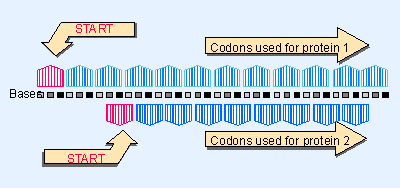9. Some DNA sequences code for more than one protein
2.9 Some DNA sequences code for more than one protein |
Most genes consist of a sequence of DNA that is devoted solely to the purpose of coding for one protein (although the gene may include noncoding regions at either end and introns within the coding region). However, there are some cases in which a single sequence of DNA codes for more than one protein.
 |
Figure 2.25 Two proteins can be generated from a single gene by starting (or terminating) expression at different points. |
Overlapping genes occur in the relatively simple situation in which one gene is part of the other. The first half (or second half) of a gene is used independently to specify a protein that represents the first (or second) half of the protein specified by the full gene. This relationship is illustrated in Figure 2.25. The end result is much the same as though a partial cleavage took place in the protein product to generate part-length as well as full-length forms.
 |
Figure 2.26 Two genes may share the same sequence by reading the DNA in different frames. |
Two genes overlap in a more subtle manner when the same sequence of DNA is shared between two nonhomologous proteins. This situation arises when the same sequence of DNA is translated in more than one reading frame. In cellular genes, a DNA sequence usually is read in only one of the three potential reading frames, but in some viral and mitochondrial genes, there is an overlap between two adjacent genes that are read in different reading frames. This situation is illustrated in Figure 2.26. The distance of overlap is usually relatively short, so that most of the sequence representing the protein retains a unique coding function.
 |
Figure 2.27 Alternative splicing uses the same pre-mRNA to generate mRNAs that have different combinations of exons. |
In some genes, alternative patterns of gene expression create switches in the pathway for connecting the exons. A single gene may generate a variety of mRNA products that differ in their content of exons. The difference may be that certain exons are option Xthey may be included or spliced out. Or there may be exons that are treated as mutually exclusive Xone or the other is included, but not both. The alternative forms produce proteins in which one part is common while the other part is different. Figure 2.27 illustrates an example in which alternative splicing leads to the inclusion of an exon in some mRNAs, while it is left out of others. (Other types of combinations that are produced by alternative splicing are discussed in 22 Nuclear splicing and RNA processing.)
A single type of transcript is made from the gene in Figure 2.27, but it can be spliced in either of two ways. In the first pathway, two introns are spliced out, and the three exons are joined together. In the second pathway, the second exon is not recognized. As a result, a single large intron is spliced out. This intron consists of intron 1 + exon 2 + intron 2. In effect, exon 2 has been treated in this pathway as part of the single intron. The pathways produce two proteins that are the same at their ends, but one of which has an additional sequence in the middle. So the region of DNA codes for more than one protein.
Sometimes two pathways operate simultaneously, a certain proportion of the RNA being spliced in each way; sometimes the pathways are alternatives that are expressed under different conditions, one in one cell type and one in another cell type.
 |
Figure 2.28 Alternative splicing generates the a and b variants of troponin T. |
In some cases, the alternative means of expression do not affect the sequence of the protein; for example, changes that affect the 5′ nontranslated leader or the 3′ nontranslated trailer may have regulatory consequences, but the same protein is made. In other cases, one exon is substituted for another, as indicated in Figure 2.28.
In this example, the proteins produced by the two mRNAs contain sequences that overlap extensively, but that are different within the alternatively spliced region. The 3′ half of the troponin T gene of rat muscle contains 5 exons, but only 4 are used to construct an individual mRNA. Three exons, WXZ, are the same in both expression patterns. However, in one pattern the α exon is spliced between X and Z; in the other pattern, the β exon is used. The α and β forms of troponin T therefore differ in the sequence of the amino acids present between sequences W and Z, depending on which of the alternative exons, α or β, is used. Either one of the α and β exons can be used to form an individual mRNA, but both cannot be used in the same mRNA.
So alternative (or differential) splicing can generate proteins with overlapping sequences from a single stretch of DNA. It is curious that the higher eukaryotic genome is extremely spacious in having large genes that are often quite dispersed, but at the same time it may make multiple products from an individual locus. It is not possible to say how many genes have alternative modes of expression, but on an anecdotal basis, the number seems to be a few percent.